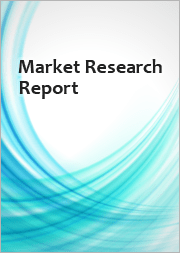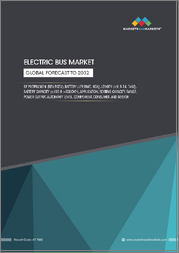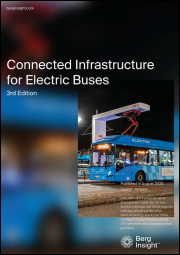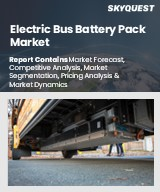
|
시장보고서
상품코드
1457926
세계의 전기 교통 버스 및 코치 시장 : 성장 기회(2030년)Global Growth Opportunities in the Electric Transit Bus and Coach Market, 2030 |
||||||
유럽, 북미, 인도에서 산업 부활
배기가스 규제, 배터리 가격 하락, 저배가스 구역 출현, 구매 보조금, 면세 조치가 세계의 전기 버스 성장을 가속할 것으로 보입니다. 전기 수송 버스의 채용 확대에 의해 대체 파워트레인 버스의 세계의 조달, 공급의 길이 열렸습니다. 이 산업은 기존 자동차 제조업체, 공급업체, 시장 진입을 목표로 하는 신규 진출기업들 사이에 강력한 협력 체제가 구축되는 비옥한 토양이 되고 있습니다. 2023년까지 배터리 전기(BEV) 버스가 더 큰 시장 점유율을 얻고 연료전지 전기 버스가 계속될 것으로 보입니다. 디젤버스에 비해 전기버스의 총소유비용은 낮아 충전 인프라 정비가 추진되고 있기 때문에 2024년-2026년에 걸쳐 전기버스는 수익성이 높은 옵션이 될 것으로 보입니다.
세계의 전기 버스 시장 규모는 복합 연간 성장률(CAGR) 12.6%로 성장할 전망이며 2030년까지 16만대 이상에 달할 것으로 예측됩니다.
EU 국가의 청정자동차 지령 목표는 특히 대중교통조달의 일환으로 전기버스의 채용을 촉진할 것으로 보입니다. 2022-2025년에 걸쳐 BEV 버스는 강력한 성장을 이룰 것으로 보입니다. Joint Initiative for Hydrogen Vehicles across Europe(JIVE) 프로젝트는 EU 국가에서 연료전지 버스의 채택을 촉진합니다. 전력 및 에너지 대기업의 전기 충전 인프라 진입은 전기자동차 연료 공급 인프라의 성장을 뒷받침합니다.
중국에서는 보조금과 구매 인센티브의 폐지로 인해 2022-2025년에 걸쳐 BEV 버스는 완만한 성장을 이룰 것으로 보입니다. 중국의 보조금 제도 개정에서는 전기 주행 거리와 에너지 효율의 한계치가 자격의 최저 요건으로 엄격화되었습니다. 그러나 배터리 가격의 저하와 충전 인프라의 정비에 의해 2030년을 향해 전기 버스의 보급이 진행될 것으로 예상됩니다. 또한 중국의 전기 버스 OEM은 수출뿐만 아니라 제조 및 조립 공장의 설립으로 빠르게 세계로 확대되고 있습니다.
ZEBRA(Zero-emission Bus Rapid-Deployment Accelerator)는 메딜린, 상파울루, 멕시코 시티에서 초기 시동을 통해 라틴아메리카에서 전기 버스 채택을 추진합니다. 라틴아메리카의 주요 국가들은 대중 교통의 제로 방출 버스를 추진하는 전기 이동성 전략을 수립하고 있으며, 중국의 OEM은 라틴아메리카에 진입하기 위해 지역 생산 기지를 설립하고 있습니다.
특히 인구가 많은 도시에서는 배출가스를 삭감할 필요성이 높아지고 있기 때문에 도시내 여객 운송 부문에서는 전기 버스의 채용 확대가 필요할 것으로 보입니다. 배터리용량 증가와 충전 인프라 기술의 적극적인 개발은 디젤 버스와 천연 가스 버스와의 엄격한 경쟁이 있더라도 그 의미에서 도움이 되어 객차 부문에서의 전기 파워트레인의 채용률을 높일 것으로 보입니다.
목차
전략적 과제
- 왜 성장이 어려워지고 있는가?
- The Strategic Imperative 8(TM)
- 전기 버스 산업에서의 전략적 중요 과제의 상위 3의 영향
- 성장 기회는 Growth Pipeline Engine(TM)을 가속
성장환경
- 세계의 버스 시장 :지역 구분
- 주목해야 할 규제와 의무: 스냅샷
- 세계의 버스 파워트레인 전망
- 주요 버스 제조업체 시장 존재
조사 범위
- 전기 버스 시장의 분석 범위
- 제품 및 기술 세분화
- 세계의 전기 버스 시장의 주요 성장 지표
- 전기 버스 채용의 성장 촉진요인
- 전기 버스 보급의 성장 억제요인
- 주요 예측 기준
성장 기회 분석 : 전기 버스 개요
- 전화에 영향을 미치는 주요 요인
- 전기 버스 시장의 시나리오 분석
- XEV 버스 시장 현황 : 지역별(2030년)
- 전기 버스 시장 : 기술별 지역 구분(2030년)
- 전기 버스의 주요 이용 사례
- 전기 버스의 지역별 가격 전망
- 전기 버스의 지역별 가격 전망
성장 기회 분석 : 전기 버스 시장 : 북미
성장 기회 분석 : 전기 버스 시장 : 유럽
성장 기회 분석 : 전기 버스 시장 : 중국
성장 기회 분석 : 전기 버스 시장 : 인도
성장 기회 분석 : 전기 버스 시장 : 라틴아메리카
성장 기회
- 성장 기회 1 : 전기에 의한 깨끗하고 제로 방출의 수송으로의 전환
- 성장 기회 2 : 밸류체인 참가자의 성장을 위한 수익 기회 확대
- 성장 기회 3 : FCEV 버스의 부문와 이용 사례에 있어서의 정세의 특정과 맵화
다음 단계
BJH 24.04.09Europe, North America, and India Will Experience a Resurgence of the Industry
Emission regulations, battery price drop, the emergence of low emission zones, purchase subsidy, and tax exemptions will drive electric bus growth across the world. The growing adoption of electric transit buses has opened the path for global sourcing and supply of alternate powertrain buses. The industry is fertile ground for strong collaborations among incumbent automakers, suppliers, and new players striving to enter the market. By 2023, battery-electric (BEV) buses will attain a larger market share followed by fuel-cell electric buses. The lower total cost of ownership of electric buses in comparison to diesel buses and the push for developing charging infrastructure will make electric buses a profitable option from 2024 to 2026.
The global electric bus market size will reach more than 160,000 units by 2030 at a compound annual growth rate (CAGR) of 12.6%.
EU Clean Vehicle directive targets for EU countries will boost electric bus adoption, particularly as part of national public transport procurement. BEV buses will experience strong growth from 2022 to 2025. Joint Initiative for Hydrogen Vehicles across Europe (JIVE) projects will encourage fuel cell bus adoption across EU countries. The entry of utility and energy major companies into electric charging infrastructure will boost the growth of fueling infrastructure for electric vehicles.
In China, BEV buses will see moderate growth from 2022 to 2025 due to the elimination of subsidies and purchase incentives. The revised subsidy program in China incorporates stricter thresholds for electric range and energy efficiencies as the minimum requirement for qualification. However, lower battery prices and charging infrastructure will drive higher electric bus adoption toward 2030. In addition, Chinese electric bus OEMs are rapidly expanding globally, with the establishment of manufacturing and assembly plants, in addition to exports.
Zero-emission Bus Rapid-Deployment Accelerator (ZEBRA) will drive electric bus adoption in Latin America with initial kickstarts in Medellin, Sao Paulo, and Mexico City. Major LATAM countries are developing an electromobility strategy promoting zero-emission buses in public transportation, and Chinese OEMs have established regional production bases to tap into LATAM.
The increasing need to reduce emissions, especially in highly populated cities, will require a greater adoption of electric buses in the intra-city passenger transport segment. Growing battery capacities and aggressive development in charging infrastructure technologies will help in that sense, increasing the adoption rate of electric powertrains in the coaches segment, albeit with stiff competition from diesel and natural gas buses.
Table of Contents
Strategic Imperatives
- Why Is It Increasingly Difficult to Grow?
- The Strategic Imperative 8™
- The Impact of the Top 3 Strategic Imperatives on the Electric Bus Industry
- Growth Opportunities Fuel the Growth Pipeline Engine™
Growth Environment
- Global Bus Market: Regional Split
- Notable Regulations and Mandates: A Snapshot
- Global Bus Powertrain Outlook
- Market Presence of Leading Bus Manufacturers
Study Scope
- Electric Bus Market Scope of Analysis
- Product and Technology Segmentation
- Key Growth Metrics for Global Electric Bus Market
- Growth Drivers for Electric Bus Adoption
- Growth Restraints for Electric Bus Adoption
- Key Forecast Criteria
Growth Opportunity Analysis: Electric Bus Overview
- Key Factors Impacting Electrification
- Electric Bus Market Scenario Analysis
- Snapshot of xEV Bus Market by Region in 2030
- Electric Bus Market: Regional Split by Technology, 2030
- Key Electric Bus Use Cases
- Electric Transit Bus Regional Pricing Outlook
- Electric Coaches Regional Pricing Outlook
Growth Opportunity Analysis: Electric Bus Market, North America
- Key Growth Metrics for Electric Bus: North America
- Regional Snapshot
- Incentives: North America
- Electric Bus Market Scenario Analysis: North America
- Transit Bus Market: Powertrain Forecast, North America
- Coaches Market: Powertrain Forecast, North America
- OEM Powertrain Technology Platforms
- Key BEV and FCEV OEM Product Portfolio
- OEM Motor and Battery Chemistry Mapping: North America
- Battery and Fuel Cell Electric Bus Deployment: OEMs and NA Regions
Growth Opportunity Analysis: Electric Bus Market, Europe
- Key Growth Metrics for Electric Bus: Europe
- Regional Snapshot
- Incentives: Europe
- Electric Bus Market Scenario Analysis: Europe
- Transit Bus Market: Powertrain Forecast, Europe
- Coaches Market: Powertrain Forecast, Europe
- OEM Powertrain Technology Platforms
- Key BEV OEM Product Portfolio
- Key FCEV OEM Product Portfolio
- OEM: Motor Type Mapping, Europe
- OEM: Battery Chemistry Mapping, Europe
- Regional Snapshot: Germany
- Regional Snapshot: France
- Regional Snapshot: Spain
- Regional Snapshot: Italy
- Regional Snapshot: United Kingdom
- Battery Electric Bus Deployment: OEMs and EU Countries
- Fuel Cell Electric Bus Deployment: OEMs and EU Countries
Growth Opportunity Analysis: Electric Bus Market, China
- Key Growth Metrics for Electric Bus: China
- Regional Snapshot
- Incentives: China
- Electric Bus Market Scenario Analysis: China
- Transit Bus Market: Powertrain Forecast, China
- Coaches Market: Powertrain Forecast, China
- OEM Powertrain Technology Platforms
- Key BEV OEM Product Portfolio
- Key FCEV OEM Product Portfolio
- Battery Electric Bus Deployment: OEMs and Chinese Cities
- Fuel Cell Electric Bus Deployment: OEMs and Chinese Cities
Growth Opportunity Analysis: Electric Bus Market, India
- Key Growth Metrics for Electric Bus: India
- Regional Snapshot
- Incentives: India-FAME-II
- Electric Bus Market Scenario Analysis: India
- Transit Bus Market: Powertrain Forecast, India
- Coach Market: Powertrain Forecast, India
- OEM Powertrain Technology Platforms
- Key BEV OEM Product Portfolio
- OEM Motor and Battery Chemistry Mapping: India
- Electric Bus Deployment: OEMs and Indian States
Growth Opportunity Analysis: Electric Bus Market, Latin America
- Key Growth Metrics for Overall Bus: LATAM
- Regional Snapshot
- Incentives: LATAM
- Electric Bus Market Scenario Analysis: LATAM
- Transit Bus Market: Powertrain Forecast, Latin America
- Coaches Market: Powertrain Forecast, Latin America
- OEM Powertrain Technology Platforms
- Key OEM Product Portfolio
- OEM Powertrain Motor Type Mapping
- OEM Powertrain Battery Type Mapping
- Electric Bus Deployment: OEMs and LATAM Countries
Growth Opportunity Universe
- Growth Opportunity 1: Moving Toward Cleaner and Zero-emission Transportation through Electrification
- Growth Opportunity 2: Expanding Revenue Opportunities for Value Chain Participant Growth
- Growth Opportunity 3: Identify and Map the Opportunity Landscape for FCEV Buses Across Segments and Use Cases
Next Steps
- Your Next Steps
- Why Frost, Why Now?
- List of Exhibits
- Legal Disclaimer



















